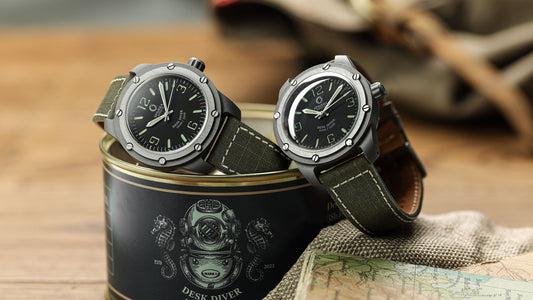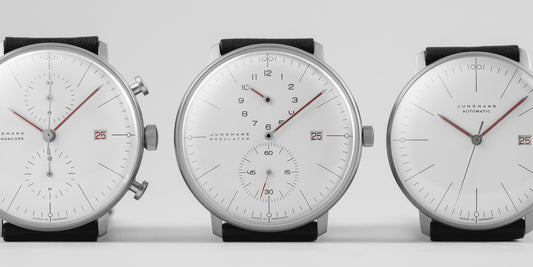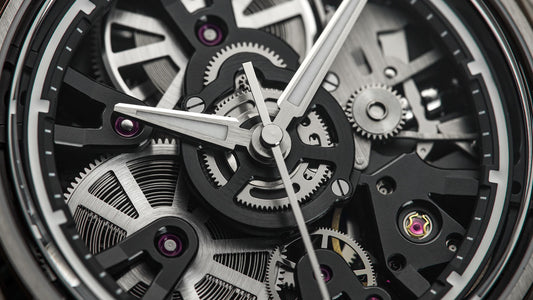It's true! After 'What is a pilot watch?' and 'What is a chronograph watch?, questions about the various pilot chronograph functions are amongst the most regular that we're asked at WatchGecko.
So, What is a Chronograph Watch?
The chronograph (literally 'time writer') is one of the most complex, sophisticated (or 'difficult' as the horologists say) watch complications that man has devised.
In the Glossary of The Watch Book by Gisbert L. Brunner and Christian Pfeiffer-Belli, Chronograph is defined as follows:
'A chronograph – or more correctly "chronoscope" – is a watch with an hour-hand, a minute-hand, and a special additional mechanism which, at a push of a button, alternately starts a (usually) centrally positioned elapsed-seconds hand, stops it, and returns it to its zero position. The ordinary time display remains unaffected.'
Chronograph vs. Chronometer.
 Zenith El Primero - Credit WatchGecko
Zenith El Primero - Credit WatchGecko
Let's quickly clarify another common misunderstanding: the confusion between chronographs and chronometers. A chronograph is not necessarily a chronometer, although some chronometers are chronographs.
Back to The Watch Book for another definition: 'A chronometer is a precise timepiece which has proven the accuracy of its rate during a 15-day test at one of the official watch-testing authorities, e.g., the COSC (Contrôle Officiel Suisse des Chronomètres) in Switzerland.' Got it? Good, let's get back to pilot chronographs.
Ever since Louis Mainet experimented with his 'Compteur de Tierces' in 1816, or Nicholas Rieuss developed his (literally)' time writer', man has been perfecting devices used to measure small amounts of time. Over more than a century, the ingenuity of watchmakers has led to a wide range of chronograph watch functions for sports, medicine, military applications, and, since the invention of the airplane, for aviation. And that's where we're going to focus now, as we look at the chronograph watch functions often associated with pilot watches.
 Laco Padderborn Erbstuck - Credit WatchGecko
Laco Padderborn Erbstuck - Credit WatchGecko
Just as unidirectional bezels and Helium release valves have insinuated themselves into dive watch culture, certain features have a similar role in pilot watches – particularly pilot chronographs.
Although knowing how to use a chronograph watch to its fullest potential isn't essential for many owners, understanding the functions and their applications can only add to the pleasure of ownership. We reckon a fully featured 'dream' pilot's chronograph would have the following features and characteristics – the characteristics of a basic 'pilot's watch with chronograph and other functions added:
Accuracy – To a Point
If a watch works within generally accepted accuracy standards, it's going to be accurate enough for civilian aviation and probably for many military uses. In most flying, accuracy to within a few seconds is more than good enough. COSC-certified chronometers are not required!
In the highly recommended Skyfaring: A Journey with a Pilot, airline captain Mark Vanhoenacker says, '…I am required to wear a watch to work –digital or analog – and to check its accuracy before departure.'
Similarly, in Cockpit Confidential: Everything You Need to Know About Air Travel: Questions, Answers and Reflections, airline pilot Patrick Smith says, 'The purpose of the watches is to tell us what time it is. Watches are required as backups to the ship's clocks, but nothing more elaborate than a sweep hand is needed.'
Easy Readability
 Laco Kempton - Credit WatchGecko
Laco Kempton - Credit WatchGecko
As discussed in our earlier article on Fliegeruhren, most of the original pilots' watches, as exemplified by timepieces such as IWC's 1940 Big Pilot watch, featured highly legible, heavily-plumed hands, numerals, and indices. These were typically light-colored for high contrast against a simple dark dial (usually matte black).
Minimizing distracting dial details (such as date functions and even manufacturers' names) was usual, although the evolution of these watches and refinement of materials and finishes means additional functions and details have found their way onto dials.
Just compare the Big Pilot with IWC's contemporary pilot watch chronographs, such as the REF.IW377704. You'll quickly appreciate how the company's designers and watchmakers have worked hard to retain readability and clarity while introducing sophisticated day, triple-date and three-sub-dial functionality.
Of course, for legibility, some watches are better than others. But it says a lot about the changing role of wristwatches in aviation that many modern pilot chronographs are intrinsically 'over-complicated.' They are often hard to read, too, as well as difficult to use under some conditions. This is particularly the case when compared to early pilot watches' much purer visual language.
One of the greatest challenges to readability under any lighting conditions comes from pilot chronographs with slide-rule and tachymeter functions. These are among the watches marketed most directly to the aviation community, such as Breitling's iconic Navitimer or Seiko's SNA411 pilot chronograph. Then there's the way even the best non-radioactive watch luminescence will diminish rapidly after a few hours in a dark cockpit. That makes the watch even harder to use several hours into, say, a transatlantic night flight.
 Laco Kempton - Credit WatchGecko
Laco Kempton - Credit WatchGecko
Elapsed-time Stopwatch Function for up to 12 hours
Back in the days when dead reckoning air navigation was the norm, it was necessary to have a record of elapsed time along a chosen course. The term dead reckoning comes from DEDuced Reckoning, a form of navigation known to mariners for thousands of years. It involves plotting an aircraft's position by calculations of speed, course, time, effects of wind, and previous known position.
Dead reckoning is a basic skill that's still taught to aviators, even in our age of high-technology navigation aids. In the Practical Navigation section of The Private Pilot's Licence Course, Jeremy M. Pratt says: 'If nothing else [dead reckoning] will always work even if every item of avionics in the aircraft has ceased functioning. All that is needed is a watch, a compass, and an airspeed indicator.'
Flyback capability
Flyback functionality ('retour-en-vol' or 'instant restart') has an important role in military aviation as it enables a pilot to quickly read the timing for two consecutive events. For instance, when navigating between two waypoints followed immediately by the start of timing to a third waypoint or calculating consecutive average speeds.
Alternatively, it might be used during a series of timed aerobatic movements immediately following each other. The beauty of the flyback function is instantaneous resetting. This avoids the extra workload and time lag of three pushes on two buttons (on a basic two-pusher chronograph).
Rattrepante double stopwatch complication
Now compare flyback with the rarer and much more complicated rattrapante stopwatch function. The word 'rattrapante' comes from the French word 'rattraper' ('to catch up with'). A rattrapente complication (also 'split seconds' or 'doppelchrono' in German) uses two sweep hands (and sometimes also two hands on the minutes sub-dial). These hands can register two (but only two) consecutive intervals.
With the mechanism reset, and despite having two seconds hands, the watch appears to have just one second hand. When the timer is started, the two hands rotate as one. However, when the stopwatch button is pressed, one hand stops. The other keeps rotating until it, too, is stopped by a second press of the pusher. Thus, two consecutive times can be easily recorded, and the differential is seen (for instance, when two aircraft compete on an air-race lap).
Antimagnetic Properties
From the earliest days of putting watches into aircraft cockpits, watchmakers were challenged to protect their precision movements from the effects of magnetism created by aircraft. Whether from the magnets in other flight instrumentation or from having a two-metre-long Merlin engine just in front of a Spitfire's cockpit, magnetism and its ability to make watches inaccurate have always been the enemy of pilot watches.
The initial answer (still used today, but with the addition of other refinements) involved including an iron Faraday cage to channel magnetism around the movement. More recent innovations include using specialized alloys for balance springs and the latest amagnetic silicon hairsprings.
Rotary Slide Rule (E6-B)
 Breitling Navitimer - Credit WatchGecko
Breitling Navitimer - Credit WatchGecko
The rotary slide rule on your pilot chronograph has its origin back in the days before the widespread availability of electronic calculators, smartphones, and the other modern calculation devices that are ubiquitous today. Remember that within the lifetime of the writer, and probably that of some readers, navigational calculations and complete aircraft design were done with slide rules!
Originally popularised by Breitling on its 1952 Navitimer, the miniature rotary slide rule has become one of the features most readily associated with pilot watches and chronographs in popular perception. As a Forbes article explained, the rotary slide rule is more than just a redundant historical vestige. It's an adaption of the E6-B' whiz wheel' flight computer developed in America in the 1930s. In fact, it's the same manual flight computer that is still used in basic training for civilian and military pilots the world over.
 Breitling Navitimer - Credit WatchGecko
Breitling Navitimer - Credit WatchGecko
Knowing how to use chronograph watch functions such as the slide rule is undoubtedly impressive – whether in the airfield ops room or down at the pub. If you know how to operate it, the rotary slide rule on your pilot chronograph bezel can still be used for a wide range of general calculations as well as aviation-specific calculations. The latter include metric: Imperial conversions, airspeed, and rate of descent calculations.
Be warned, though, using the rotary slide rule on a Navitimer or Seiko SNA411 is fiddly, especially in a cramped, dark cockpit, in turbulence, under IFR flying conditions! With one or more accurate cockpit clocks, calculators, smartphones, and other aids in most modern cockpits, fiddling with the 42mm-diameter rotary slide-rule on your pilot watch may be more of a nuisance than a benefit!
Tachymeter (or 'tachymeter') scale.
This is another scale typically associated with chronographs and not to be confused with the 'telemeter' scale that appears on some chronographs for calculating the distance of an event, such as artillery muzzle flashes or lightning.
A tachymeter is for calculating speed (based on travel time) or distance based on speed. It's simply a way to convert elapsed time into speed (in units per hour). In the case of aircraft, that means conversion of airspeed to ground speed. Depending on the watch, the tachymeter may be engraved or printed around the watch's circumference or as a spiraling scale about the center of the watch's face.
Hacking Complication (also 'stop-second')
 Longines Spirit - Credit WatchGecko
Longines Spirit - Credit WatchGecko
This refers to a mechanism that enables you to stop a watch's second hand by pulling the crown out to the time-setting position. This allows the watch to be set precisely against a time signal or synchronized with a reference watch.
Though not specifically mentioning pilot chronographs, pilot watches, or 'hacking,' this responsibility was central to an amusing scene in Joseph Heller's classic 1960s novel Catch-22. You can read it on pages 236–8 of the book as Major Danby, the officer presiding over a mission briefing, is frustrated in his attempts to get aircrew to synchronize their watches amid various other mayhem.
Returning to the practicalities of 'watch hacking' in aviation, in his highly detailed and painstakingly researched article in the December 2006 issue of The Horological Journal, German military watch expert Konrad Knirim describes Luftwaffe crew members synchronizing their service wristwatches to their navigator's B-Uhr. In turn, this was synchronized with the pilot's chronograph, which was 'synched' with the ground-based chronometer in the airfield ops room. The latter was, in turn, synched to the central Seewerte (observatory) in Hamburg.
Dual-time capability
 Rolex GMT - Credit WatchGecko
Rolex GMT - Credit WatchGecko
In 1853, Tissot made the first dual time-zone watch, a watch that can display local time and time in one or more different time zones. The idea has evolved, through many manifestations, into what is nowadays probably the most useful function of a chronograph or standard watch for most long-haul pilots.
As Ryan Schmidt explains in The Wristwatch Handbook, 'When the wristwatch was conceived, there was not a great deal of global travel, nor was the world strung together by cables, satellites, and cell towers.' How communications, aviation, and watches have changed since then.
Following the rise in long-distance rail travel in the 1850s, the 1884's International Meridian Convention established the prime meridian at Greenwich and the adoption of the 24-hour global time zone concept that we take for granted today. Later, the growth of international air travel in the 1940s and 1950s increased the requirement for pilots and travelers to be able to quickly tell the time across one or more international time zones.
The simplest way to do this is with a mechanism that links the time in the two time zones – hence the dual-time complication as demonstrated on chronograph and non-chronograph watches such as the Rolex GMT, IWC Pilot Worldtimer, Breitling Chronomat GMT, Chronoswiss Timemaster GMT, George J. von Burg GMT Fly-back and Vulcain Aviator GMT.
By having a 24-hour register, separate dual-time hand and rotating 24-hour bezel, it's possible to monitor time in three different time zones. Or for a home time, destination time and Universal Coordinated Time (UTC), the world aviation time standard.
 Rolex GMT - Credit WatchGecko
Rolex GMT - Credit WatchGecko
Worldtimer Functionality
Related to dual-time watches are so-called 'world timer' watches that simultaneously show time in some or all of the world's time zones – usually identified by a display of exotic city names that represent the time zones. As an aside, a fascinating article in the online Financial Times analyzed the places used to represent the different time zones on 25 different World time watches from 1951 until the present (World time watches tell a story of wealth and power – www.ft.com, June 2, 2016) and found significant differences in the places mentioned between 1951 and 1971 and those mentioned between 2005 and 2016. Although a handful of cities (London, Tokyo, Sydney, New York, and Rio de Janeiro) maintained their place, many others changed – something the FT interpreted as reflecting changing concentrations of wealth and power around the world.
Worldtimer functionality is often included with chronographs. For example, at the very affordable end (sub-$350) is a watch such as the quartz-powered Junkers Worldtimer Chronograph Watch 6892-5. At the other extreme, Patek Phillipe's 5930G World Time Chronograph will put the best part of $75,000 on a (very well-paid) pilot's credit card!
As mentioned above, world timer watches such as the Breitling Transocean Chronograph Unitime are characterised by having city names circumferentially, radially around the dial, or on a sub-dial. They may be manually operated (as on the highly affordable but non-chronograph Seiko J Springs World Time) or work through sophisticated mechanical integration with the rest of the movement on more expensive watches.





